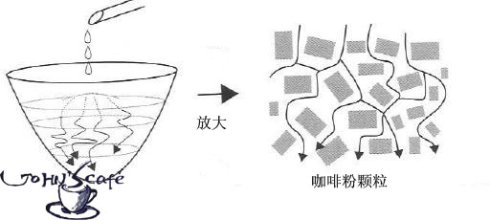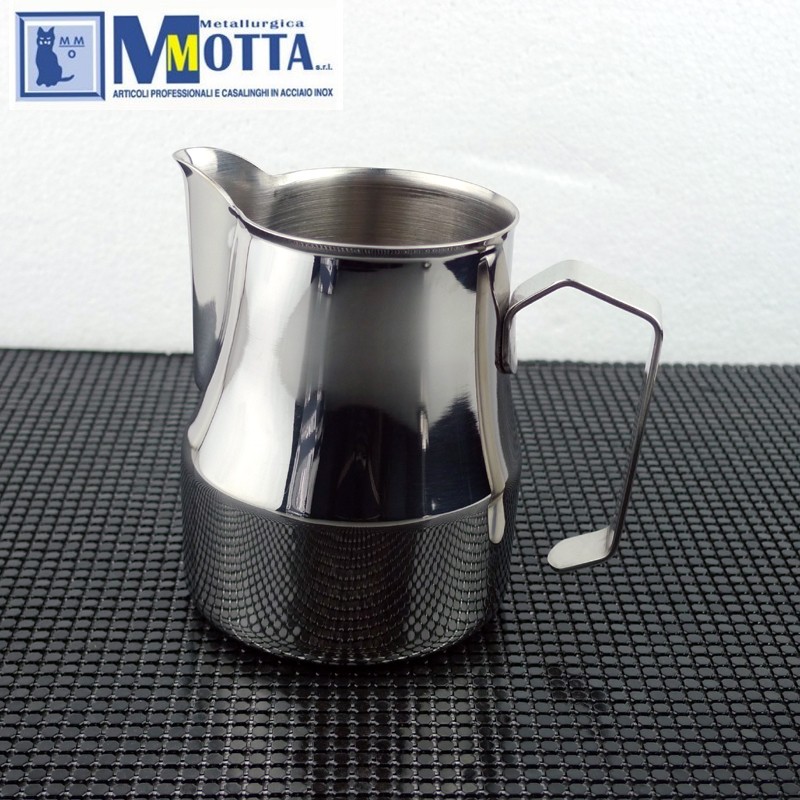Introduction to coffee utensils: the difference between the influence of sharp-mouth flower jar and long-mouth flower jar on milk foam pattern
There are now two types of flower pots.
One has a sharp beak (Figure 1) and one has a long beak (Figure 2).
What is the focus of the study? We do not discuss the volume of the drawing cylinder, but the influence of the mouth of the drawing cylinder on the drawing (as shown in Figure 3).
Let's start by dividing the mouth into a simple frontmost arc-let me name it "lip," the blue arc at point A in Figure 3; followed by the red line "neck," and the two "waists" at points B and C.
So what is the role of the mouth on the flower jar? is to give the prepared foam a running outlet.
Generally we commonly used pull flower jar is as shown in Figure 1 of the sharp mouth. So how does this tip work on foam? Excluding foam density and hand gestures, we assume that foam is the same foam, the technique is the same.
BC two points of the waist actually play a role in restricting the flow of milk foam, red two sides (neck) and the angle between the cup ring also has a limiting effect on milk foam. Such a mouth, ABC 3 points into an equilateral triangle situation, in the process of passing through the mouth, milk is gradually forced to a point (in fact, an arc outlet); especially in the case of deliberate control of flow, large milk bubbles will be blocked by the neck wall and gradually restricted; and because the pouring path is too short to control the amount of milk poured out, it is difficult to control the pouring point freely, and it takes practice to master and pull out good flowers at will.
However, as shown in Figure 2 of the long-mouthed flower pulling cylinder, it can be seen from Figure 4 that the tip of the long-mouthed flower pulling cylinder is extended, and the retraction angle of the neck is almost perpendicular to the tangent of the water outlet, the milk foam is reduced by the restriction of the two waists, and the dense milk foam will not be reduced much; and the extension of the pouring path can be controlled by a relatively large amount to better control the flow rate. And the lengthened mouth in the fixed point and retraction on the relatively short mouth to operate some simple, so in the pattern of the performance is easier to do fine better.
We might think that if I take the pointed mouth and squeeze the waist with pliers and then change the angle of the neck so that it's closer to vertical, I can artificially create the long mouth effect, right?
An important question has emerged from the experiment:
The angle was changed by pinching the neck walls with sharp nose pliers, but it was found that this change affected the shape of the arc at point A. At this time, I tried to pull flowers, because the exit arc became shorter (closer to the point), the impact force of the milk poured out became stronger, and it was easy to rush into the bottom of CREMA instead of mixing, which caused the milk foam to rise from CREMA instead of mixing and floating; and the dense milk foam was intuitively reduced, and the pattern pulled out was very fine and not obvious.
From this we can see the importance of the exit arc. The shape here cannot be easily changed or shortened. As seen in Figure 4, the A point exit arc of the long mouth is almost semicircular, and the A point arc of the relatively sharp mouth is longer, and the reduction of milk foam is also smaller.
Therefore, if you want to change the angle between the neck wall of the pointed mouth and the tangent of the cup mouth, you must pay attention to the modification of the exit arc.
Source:
Sylvie's blog
Important Notice :
前街咖啡 FrontStreet Coffee has moved to new addredd:
FrontStreet Coffee Address: 315,Donghua East Road,GuangZhou
Tel:020 38364473
- Prev

Coffee brewing method: introduction to the importance and operation points of water injection in the center of hand-flushing manipulation
I have been using the central water injection method since I touched the hand, that is, I only inject water in the center without spreading it, and a small hole will be formed after extraction. As opposed to the central water injection method is the immersion method, that is, the whole coffee noodle is injected with water. Many friends feel that the central water injection method may not be able to extract completely, but my feeling is that the central water injection can extract completely, but it is the immersion method.
- Next

Italy MOTTA stainless steel coffee foam flower cup
[Brand] MOTTA [Name] 350CC 500CC 700CC [Model] art.901 [Material] 18/10 medical grade stainless steel [Origin] Italy [Capacity] 350ml pull cup size: upper diameter about 62mm, height about 95mm, bottom diameter about 75mm 500ml pull cup size: upper diameter about 68mm, height about 105mm, bottom diameter about 85mm 750ml
Related
- What is the meaning of lactic acid fermentation with coffee bean treatment?
- How to judge the state of foam by sound?
- How does the latte pull out the unicorn pattern? Come to get for a little trick to improve the flower pull!
- Will flower pulling affect the taste of the latte?
- Do you know the history of coffee?
- The difference between honey treatment and sun washing what is raisin honey treatment?
- What kind of milk can a novice use to make coffee foam to keep the foam longer? The correct method and skills of milking tutorial sharing
- Why do washed coffee beans taste sour? Flavor characteristics of washed Coffee
- Introduction to the skill of how to practice the size and height of water injection around the circle of hand-brewed coffee
- How do beginners practice coffee flower drawing from scratch?

